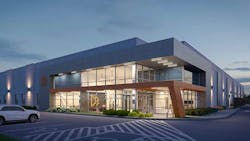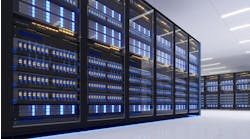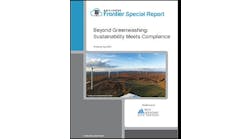DataBank is in growth mode, and the colocation and edge computing specialist continues to roll out new data center projects to expand its network. The company has announced eight data center projects over the past five months, and has just raised an additional $330 million to fund its expansion.
Today DataBank announced a new data center building in Northern Virginia, where it plans to add up to 40 megawatts of capacity in Data Center Alley in Ashburn. The IAD3 building will significantly boost DataBank’s footprint in one of the most strategic interconnection markets, where it currently operates an 18 MW facility acquired through its purchase of the zColo portfolio last year. IAD3 will offer 4MW of power in its first phase, which is expected to come online in the first quarter of 2023.
“This Ashburn data center more than doubles our colocation footprint in Loudoun County, providing a high-quality colocation solution for cloud, content, technology and Fortune 500 customers,” said DataBank CEO Raul Martynek. “DataBank is investing extensively across our portfolio nationwide, and IAD3 represents a tremendous opportunity for our clients to take advantage of Ashburn’s location and proximity the world’s Internet traffic.”
Secured Notes Power Growth Strategy
DataBank is a colocation provider operating in both primary and secondary data center markets. It is owned by DigitalBridge, a real estate firm with a vision for converged digital infrastructure, bringing together hyperscale, colocation, modular data centers, small cell networks and fiber to create a converged digital infrastructure.
DataBank has been an active consolidator, buying C7 Data Centers (2017), Edge Hosting (2017), a data center portfolio from 365 Data Centers (2017), Lightbound (2017), and now zColo (2020) and a stake in EdgePresence (2020). This series of deals transformed DataBank from a regional specialist into one of the largest U.S. data center operators, with more than 60 data centers, 1.2 million square feet of data center space, and 138 megawatts of installed UPS capacity.
The company’s growth has accelerated as DigitalBridge has begun using secured notes to raise money for new data center capacity. Back in March, DataBank raised $658 million using this strategy, which allows companies to borrow funds at a lower rate using pools of assets and cash flow as collateral. The DigitalBridge team has long used this technique to fund growth in telecom towers and other wireless infrastructure. In the data center sector, previous secured notes were backed by wholesale data centers with long-term leases and marquee tech companies as tenants, an attractive scenario for real estate investors.
The DataBank deal expands this strategy to multi-tenant data centers with enterprise tenants, who typically are governed by service agreements with shorter terms. Investors were enthusiastic about the March offering, allowing DataBank to issue a second offering of secured notes last month, raising $330 million.
“The strong reception we received on this financing reflects DataBank’s momentum and leadership in the rapidly evolving edge infrastructure landscape,” said Tom Yanagi, Managing Director of DigitalBridge. “This securitization was oversubscribed with participation from 26 unique investors, demonstrating the quality of DataBank’s underlying business and the important role it plays in our digital infrastructure portfolio.”
Beyond Deals: Purpose-Built, Multi-Facility Campuses
The two note offerings have provided DataBank with nearly $1 billion to invest in expanding its infrastructure to pursue a big vision for edge computing. And they are putting that money to work.
“Edge computing is a huge opportunity and we’re helping DataBank capitalize on it,” DigitalBridge CEO Marc Ganzi said earlier this year. “This is a story about executing on converged networks.”
Ganzi recently outlined the DataBank playbook for bringing together colocation, modular data centers, small cell networks and fiber to create a converged digital infrastructure. That effort has accelerated in 2020 as DataBank has acquired zColo and invested in modular specialist EdgePresence, massively increasing its data center footprint and edge capabilities.
It all comes together in a major building boom, as DataBank expands its existing campuses while also pursuing new construction in key markets. Here’s an overview:
- Last week the company opened the doors at MSP3, an 86,000 square foot data center in Brooklyn Park, Minnesota, featuring a first phase of 1.5 MWs of capacity. The purpose-built facility can support 9 MWs, and the 14-acre campus has room for an additional 170,000 SF and 18 MWs of data center capacity.
- Last month DataBank bought 34 acres in Orangeburg, New York, about 25 miles north of Manhattan. where it plans to build a new 200,000 square foot data center with 150,000 square feet of raised flooring, offering 30 MW of critical power. The property includes an on-site substation and can support additional data center space.
- In October the company said it will add two new data halls at its Kansas City KC3 data center, each with 1 MW of power.
- In September DataBank unveiled two expansion projects in the Salt Lake City market, adding 20,000 SF and 4 MWs of capacity at its SLC5 site, and breaking ground on a 23-acre new campus that will kick off with SLC6, a 100,000 SF data center with 22 MW of power. The property in Bluffdale, Utah includes a 66 MW substation to support future capacity.
- In July purchased an existing facility at 6961 S. Quentin Street in Centennial, Colorado, which will become DataBank’s 5th Denver data center. The property includes an existing 108,000-square-foot light-industrial facility that can be rapidly retrofitted for data center use, yielding 75,000 square feet of raised floor space and 15 megawatts of UPS power
- In July DataBank also announced the expansion of its DFW3 data center in Plano, Texas in the heart of the Dallas Telecom Corridor, ringing an additional 12,000 square feet of raised flooring and an additional 1.5MW of power online.
The flurry of activity reflects DataBank’s ambition to build runway for a long-term expansion in key markets for edge computing, featuring new construction and campuses that can support multiple facilities that can be built as demand grows over time.






